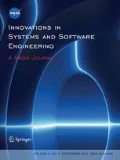Abstract
Segmentation of vasculature specific to the patients’ carotid vasculature is a complicated and challenging task because of its complex geometrical structure and interconnections. Accurate or approximate digital phantoms of the vasculature are extremely useful in quick analysis of the vascular geometry and the modelling of blood flow in the cerebrovasculature. All these analyses lead to effective diagnosis and detection/localization of the diseased arterial segment in the cerebrovasculature. In this work, we have proposed a semiautomatic geodesic path propagation algorithm based on fuzzy distance transform to generate digital cerebrovascular phantoms from the patients’ CT angiogram (CTA) images. We have also custom-developed a 2-D/3-D user interface for accurate placement of user-specified seeds on the input images. The proposed method effectively separates the artery/vein regions from the soft bones in the overlapping intensity regions using minimal human interaction. Qualitative results along with 3-D rendition of the segmented cerebrovasculature on eight patients’ CTA images are presented here.







Similar content being viewed by others
References
Gao Z, Grout RW, Holtze C, Hoffman EA, Saha PK (2012) A new paradigm of interactive artery/vein separation in noncontrast pulmonary CT imaging using multiscale topomorphologic opening. IEEE Trans Biomed Eng 59(11):3016–3027
Guha I, Das N, Rakshit P, Nasipuri M, Saha PK (2016) Design of cerebrovascular phantoms using fuzzy distance transform based geodesic paths. In: 4th international conference on advanced computing, networking, and informatics (ICACNI-2016)
Banerjee A, Dey S, Parui S, Nasipuri M, Basu S (2013) Design of 3-D phantoms for human carotid vasculature. In: Proceedings of 2013 3rd International Conference on Advanced Computing and Communication ICACC 2013, pp 347–350
Banerjee A, Dey S, Parui S, Nasipuri M, Basu S (2013) Synthetic reconstruction of human carotid vasculature using a 2-D/3-D interface. Int Confer Adv Comput Commun Inform (ICACCI) 2013:60–65
Saha PK, Gao Z, Alford SK, Sonka M, Hoffman EA (2010) Topomorphologic separation of fused isointensity objects via multiscale opening: separating arteries and veins in 3-D pulmonary CT. IEEE Trans Med Imaging 29(3):840–851
Basu S, Raghavan ML, Hoffman EA, Saha PK (2011) Multi-scale opening of conjoined structures with shared intensities: methods and applications. Int Confer Intell Comput Bio Med Instrum (ICBMI) 2011:128–131
Basu S, Hoffman E, Saha PK (2015) Multi-scale opening—a new morphological operator. Image Anal Process ICIAP 2015:417–427
Saha PK, Basu S, Hoffman EA (2016) Multiscale opening of conjoined fuzzy objects: theory and applications. IEEE Trans Fuzzy Syst 24(5):1121–1133
Xu Y, Saha PK, Hu G, Liang G, Yang Y, Geng J (2009) Quantification of stenosis in coronary artery via CTA using fuzzy distance transform. In: Proceedings of SPIE, vol 726272620, K–72620 K–12
Svensson S (2007) A decomposition scheme for 3D fuzzy objects based on fuzzy distance information. Pattern Recogn Lett 28(2):224–232
Aubert-Broche B, Griffin M, Pike GB, Evans AC, Collins DL (2006) Twenty new digital brain phantoms for creation of validation image data bases. IEEE Trans Med Imaging 25(11):1410–1416
Saha PK, Strand R, Borgefors G (2015) Digital topology and geometry in medical imaging: a survey. IEEE Trans Med Imaging 34(9):1940–1964
Saha PK, Chaudhuri BB (1996) 3D digital topology under binary transformation with applications. Comput Vis Image Underst 63(3):418–429
Rosenfeld A, Pfaltz JL (1968) Distance functions on digital pictures. Pattern Recogn 1(1):33–61
Borgefors G (1984) Distance transformations in arbitrary dimensions. Comput Vis Graph Image Process 27(3):321–345
Borgefors G (1986) Distance transformations in digital images. Comput Vis Graph Image Process 34(3):344–371
Cuisenaire O, Macq B (1999) Fast euclidean distance transformation by propagation using multiple neighborhoods. Comput Vis Image Underst 76(2):163–172
Cuisenaire O, Macq B (1999) Fast Euclidean distance transformation by propagation using multiple neighborhoods. Comput Vis Image Underst 76(2):163–172
Danielsson P-E (1980) Euclidean distance mapping. Comput Graph Image Process 14(3):227–248
Saha PK, Wehrli FW, Gomberg BR (2002) Fuzzy distance transform: theory, algorithms, and applications. Comput Vis Image Underst 86(3):171–190
Rosenfeld A (1978) Geodesics in digital pictures. Inf Control 36(1):74–84
Yushkevich PA, Piven J, Hazlett HC, Smith RG, Ho S, Gee JC, Gerig G (2006) User-guided 3D active contour segmentation of anatomical structures: significantly improved efficiency and reliability. Neuroimage 31(3):1116–1128
Basu S, Plewczynski D, Saha S, Roszkowska M, Magnowska M, Baczynska E, Wlodarczyk J (2016) 2dSpAn: semiautomated 2-d segmentation, classification and analysis of hippocampal dendritic spine plasticity. Bioinformatics 32:2490
Acknowledgements
Authors are grateful to Dr. Robert E. Harbaugh, Penn State Hershey Medical Center and Prof. Madhavan L. Raghavan, Department of Biomedical Engineering, University of Iowa for sharing the CTA datasets used in this study. Authors are also grateful to CMATER research laboratory of the Computer Science and Engineering Department, Jadavpur University. This work is partially supported by the DST PURSE-II scheme, Government of India, and Research Award (F.30-31/2016(SA-II)) from UGC, Government of India.
Author information
Authors and Affiliations
Corresponding author
Rights and permissions
About this article
Cite this article
Guha, I., Das, N., Rakshit, P. et al. A semiautomatic approach for segmentation of carotid vasculature from patients’ CTA images. Innovations Syst Softw Eng 13, 243–250 (2017). https://doi.org/10.1007/s11334-017-0289-y
Received:
Accepted:
Published:
Issue Date:
DOI: https://doi.org/10.1007/s11334-017-0289-y




